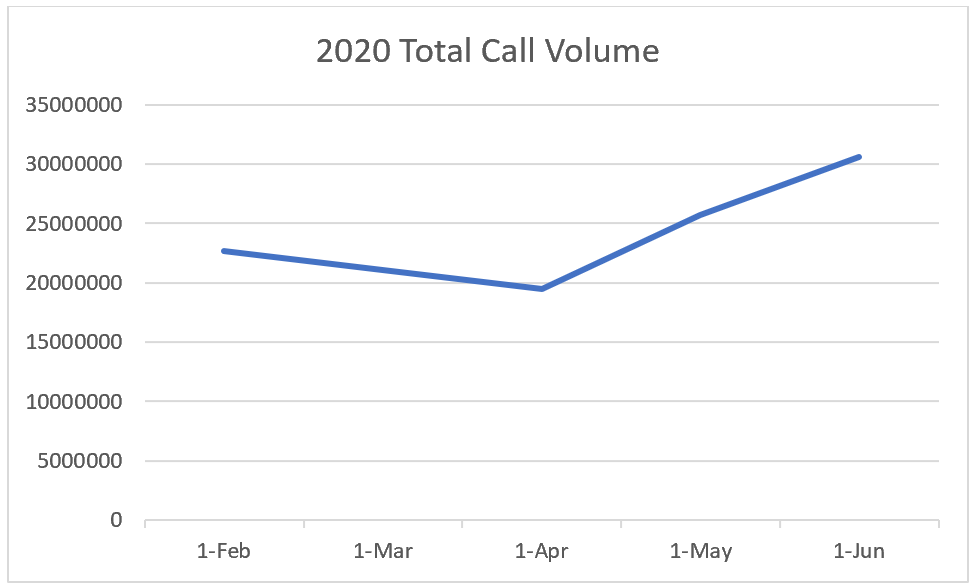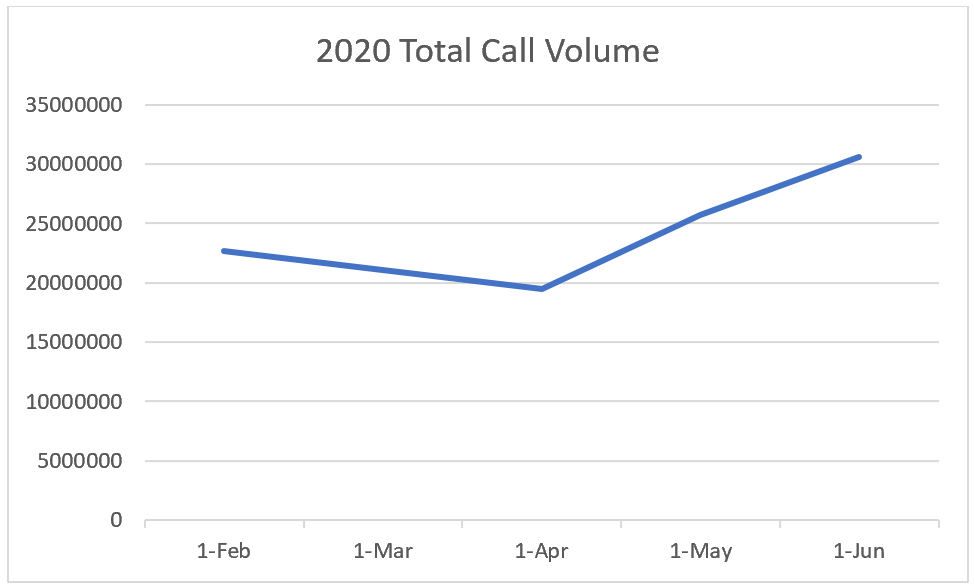One of the most obvious observations is that while we saw total national call volume tank in April, we’re seeing a steep increase in call volume heading into July. In no way should this be interpreted that we’re out of the woods, but it does signal that we’re reaching volumes that are skyrocketing above pre-COVID times and we need to react accordingly.
by Cory Wright
As the US Auto Industry heads full force into summer, consumers have now endured 3 full months of peaks, plateaus, and valleys of the coronavirus pandemic. At CallRevu, we’ve kept a close eye on call data to help us better understand the impact of these unprecedented times.
One of the most obvious observations is that while we saw total national call volume tank in April, we’re seeing a steep increase in call volume heading into July. In no way should this be interpreted that we’re out of the woods, but it does signal that we’re reaching volumes that are skyrocketing above pre-COVID times and we need to react accordingly. The phones are ringing off the hook with customers who want to understand how to do business with us.

Unfortunately, in a time when our customers need us most, some retailers haven’t reached profitability levels that allow them to bring back their full pre-COVID staffing. Some major groups have even announced that furloughed employees won’t be hired back. The impact is evident when examining unanswered calls, which are 4% higher than they were during pre-COVID months.
So how does our industry tackle more calls, with less staff to answer them?
Here are 3 areas of focus when aiming to connect more calls:
- Train your receptionist! A well-trained receptionist can be an absolute game changer. CallRevu offers customers complimentary training webinars and access to our online university to help jumpstart their growth. Check it out: www.callrevu.com/training
- Fine tune your phone process and hardware. Advanced phone systems can be setup to roll over to appointment coordinators, sale agents, BDCs, or managers. You know your team best. Work with what you have and use call data to support whether it’s working or not.
- Use your call monitoring provider! Now is a more important time than ever to leverage call monitoring. At CallRevu, we provide deal-saving alerts to help your team follow-up on missed opportunities while it’s still possible to save them. It’s not optimal to have to call a customer back, but if you can’t answer the call, you certainly don’t have time to listen to every call and triage call backs. Let us do the heavy lifting!
As we unpack departmental data, it is evident that call volume appears to be steadily increasing as a function primarily based on service inquiries. Sales calls gradually declined in June, marking a cooling off period that is congruent to much of the market data. While it’s difficult to speculate if this will continue in July, many cite that the evaporation of inventory and incentives could be a contributing factor as well as consumer confidence and uncertainty. Not only that, but customers are driving considerably less. So much that car insurance companies are adjusting insurance premiums to reflect less customers being on the road. Less cars on the road equals less accidents and lower rates passed along to the consumers.
Here’s my premium discount:

Could this be the reason why we’re seeing a steady increase in service volume even while sales inquiries simmer? It’s a likely contributor. As cars sit for extended periods of time, there is a litany of issues that can come about. Additionally, we hear an increased customer focus on how to service their vehicle vs. when they can come in. In the theme that a customer typically visits your service department every 3000 to 5000 miles, or 3-5 months, customers may not have contacted you since the pandemic started. Thus, prompting almost every customer to phone in and understand how things are different now.
They’ve been to the grocery store on a weekly basis, so they’re familiar with that process. “Contact-free” style service is new. Over the coming months, remember that many customers will still be experiencing the new normal when it comes to routine maintenance and repair.
Here are 3 ways to make the most of each call to your service department:
- Verifying accurate contact information is key! Neglecting to do this can make follow-up a nightmare. In the theme of following up, obtaining or verifying an existing email address can help ensure fluid follow up. Additionally, make it the rule to ask customers their preferred method of contact.
- Be sure to ask customer’s how their car is driving. Take note of any and all dissatisfaction. This can be valuable in providing additional services or presenting the sales team with opportunities. They need every opportunity they can get right now and will appreciate your efforts.
- Print out and practice fluidly reciting your COVID-19 protection process. It should be explained to every customer without them having to ask about it. Educating the customer eases their mind, adds value, and helps them to become ingratiated as an important part of that process that can save lives.
Service calls are often overlooked when it comes to call monitoring. However, they make up the lion-share of call volume and support the retailer ecosystem, that if leveraged properly, can not only be a lucrative profit center on its own, but also drive more opportunities to your sales department.
Not monitoring your service calls? We can help!






